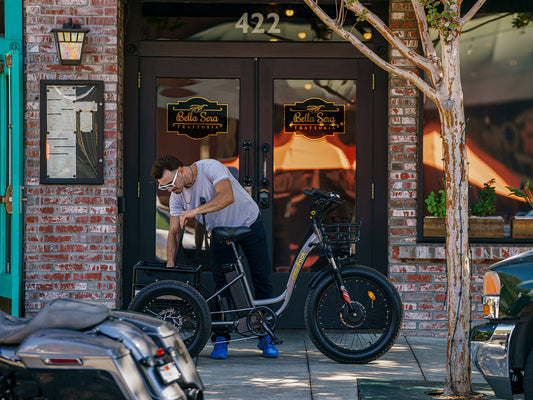The bicycle is the most efficient mode of transportation ever conceived. Effortlessly, it moves a human from one point to another. Yet, in the realm of professional sports, cycling transforms into an intense endurance challenge. The domain of the cycling elite is a sphere where triumph and heartbreak are separated by mere seconds.
This article explores the various facets that contribute to a pro cyclist's edge. We highlight rigorous training, diet, technology, and customized strategies that elevate these athletes to the zenith of their sport.

Training Regimens

Every rider follows a unique plan, tailored to their strengths and goals. Days are filled with a mix of endurance rides, sprint intervals, and strength training.
Coaches do have a role here. They analyze performance data, tweak training schedules, and ensure cyclists peak at the right time. Variety is key. One day might involve a long, steady ride; another, high-intensity interval training. This mix keeps the body guessing and growing stronger.
The training period is followed by a few rest days. They allow muscles to heal and grow. Cyclists also engage in cross-training activities like swimming or yoga, adding flexibility and preventing burnout.
Nutrition and Diet

Nutrition is the fuel that powers the engine of a pro cyclist. It is a delicate balance of carbohydrates, proteins, and fats, fine-tuned to meet the demanding energy needs of the sport. Each meal is crafted to satisfy hunger and optimize performance and recovery.
Breakfast might be a mix of complex carbs and proteins – they may take oatmeal with nuts and fruits. For lunch and dinner, the focus shifts to lean proteins and vegetables to ensure muscle repair and get essential nutrients.
Keeping the body hydrated is vital. Water, along with electrolyte-rich drinks, keeps the body balanced, especially during long rides. Snacks are strategic too. Taking energy bars or gels during training and races provides quick, accessible fuel.
Some cyclists do take supplements like protein powders and omega-3s. However, most dependency is on natural foods.
Mental and Psychological Preparation
Mental toughness is as important as physical strength in professional cycling. Cyclists cultivate a mindset of resilience, focus, and determination. They train their minds to endure pain, overcome challenges, and stay calm under pressure.

Visualization is a key technique. Riders mentally rehearse races, imagining each turn and sprint. This mental practice enhances confidence and readiness. Sports psychologists may assist, offering tools for stress management and concentration.
Another aspect is setting goals. Clear objectives guide daily training and provide motivation. But flexibility is also important. Cyclists learn to adapt to unexpected situations, like bad weather or equipment issues.
Technology and Equipment

Technology has transformed many segments and cycles have evolved. Modern bikes are marvels of engineering, designed for speed, efficiency, and aerodynamics. Every component, from the frame to the gears, is optimized for peak performance.
Cyclists work closely with technicians to customize their bikes. They consider factors like weight, stiffness, and comfort. The right bike is an extension of the rider, perfectly tuned to their style and the race conditions.
Cyclists now use smart wearable technology. Devices track heart rate, power output, and cadence, providing valuable data for training and strategy. This information guides decisions on pacing and effort during races.
Clothing is about more than style. It is engineered for aerodynamics and comfort. High-tech fabrics reduce drag and manage sweat to keep riders cool during long, strenuous rides.
Recovery and Injury Prevention

Recovery is a vital component in the life of a pro cyclist. It gives the body time to heal and rejuvenate after intense exertion.
Post-ride, cyclists often engage in cool-down exercises to ease muscle tension. Stretching and foam rolling are common practices. These activities enhance flexibility and help prevent muscle soreness.
Nutrition plays a significant role in recovery. Immediately after a ride, cyclists consume protein and carbohydrates to aid muscle repair and replenish energy stores. Hydration remains a priority, with an emphasis on replacing lost fluids and electrolytes.
Sleep is the unsung hero of recovery. Quality rest is non-negotiable which allows the body and mind to recover fully. Cyclists often aim for 8 to 10 of sleep to maximize recovery.
Injury prevention is interwoven with recovery. Regular physiotherapy sessions and attention to proper technique minimize the risk of injuries.
Racing Strategies
Racing strategies in professional cycling are as diverse as the races themselves. Each strategy is a carefully crafted plan, designed to leverage a cyclist's strengths and exploit the race's unique characteristics.
Teamwork is the heart of these strategies. The peloton, or the main group of riders, works together to reduce wind resistance, a concept rooted in aerodynamics. The rider at the front bears the most resistance, while those at the back benefit from reduced drag.
Knowledge of the course plays a significant role. Cyclists and their teams study the route in detail, noting key climbs, descents, and turns. This knowledge allows them to plan where to conserve energy and where to attack.
Conclusion

Professional cycling is a remarkable blend of human endeavor, technological innovation, and strategic mastery. At its heart lies the simple, efficient bicycle, transformed into a vehicle of extraordinary athletic performance.
Pro-cyclists who take part in international races like the Tour de France engage in a sophisticated ballet of aerodynamics, team dynamics, and individual prowess. Their training, nutrition, and recovery are as scientifically advanced as the equipment they use.




